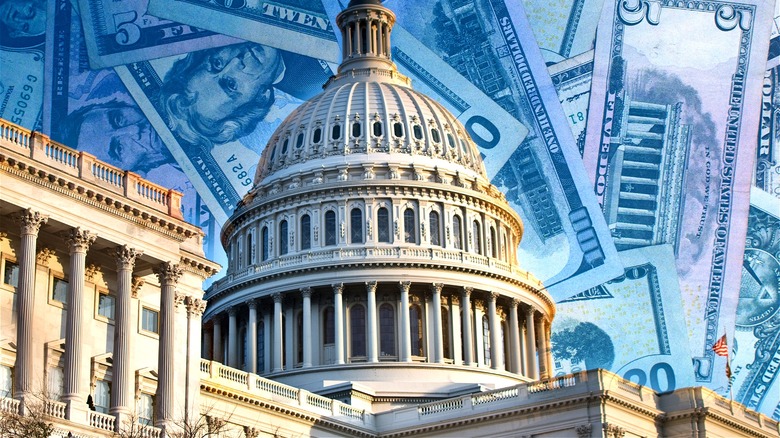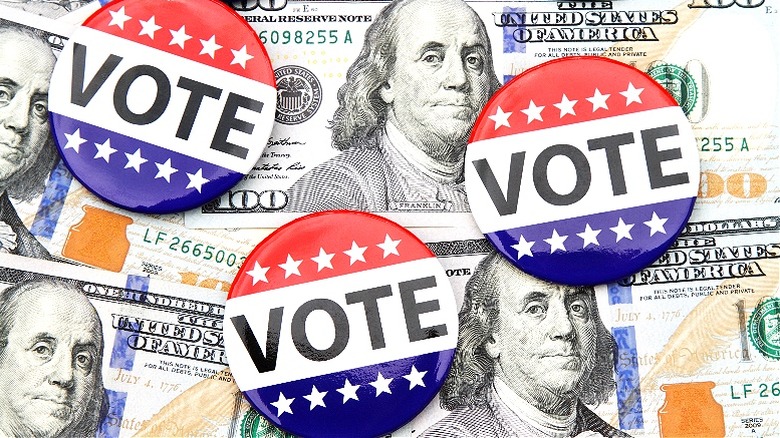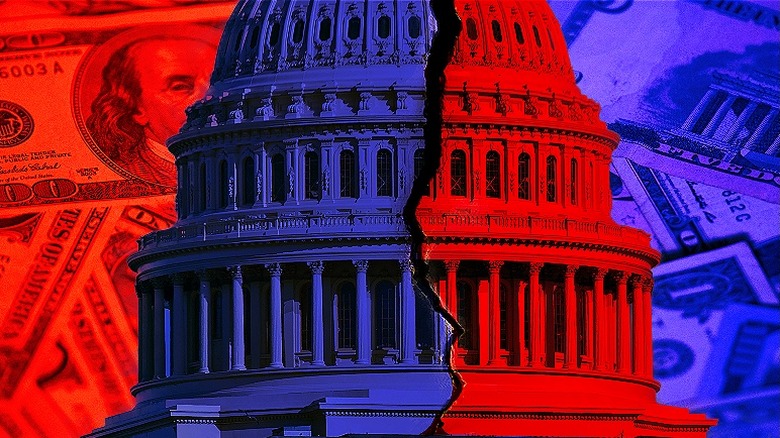Money And Politics: Everything You Need To Know About PACs
With candidates needing money to pay for everything from travel to ad buys to social media posts, political fundraising can be the key to a candidate's success, especially in battleground states. With candidates like Kamala Harris breaking fundraising records, you might find yourself wondering how political donations actually work. While your intention might be to donate to a specific candidate, chances are your donation is actually going to a political action committee, better known as a PAC.
In order to understand where exactly your political donation goes, it's important to understand the foundation of what a PAC is. At its simplest, a PAC is a tax-exempt organization that pools together campaign contributions (donations) and then donates those funds to campaigns, as well as to ballot initiatives, or even legislation. Note there are a lot of restrictions placed on these committees.
To start, an organization is considered a PAC if it receives and spends over $1,000 for the express purpose of influencing an election (at the federal level). PACs can contribute $5,000 to a candidate committee per election, $15,000 annually to a national party, and $5,000 annually to another existing PAC. Also important, is that a PAC can only receive up to $5,000 in donations for any individual person, PAC, or committee in a single calendar year. (On that note, this was the most money ever spent on a presidential campaign.)
Kinds of PACs
Since a PAC is required to disclose information about the individuals who financially contribute to them, it's important to realize there are several different kinds of PACs. While many share some of the same monetary amount restrictions, there can be differing fundraising and disclosure rules to be aware of. For starters, separate segregated funds (or SSFs) are funds that are directly connected to an organization like a corporation, labor union, or membership organization. These committees are only able to receive funds from members directly associated with whatever the primary organization is. On the flip side, a nonconnected committee can accept financial contributions from anyone in the general public.
Leadership PACs, meanwhile, are directly established by a specific candidate or person holding federal office (e.g., a member of Congress). These PACs can only contribute a maximum of $5,000 per election to any federal candidate's committee. Despite being connected to a specific candidate, these PACs remain legally separate from a candidate's official campaign committee, and thereby operating more like a nonconnected committee.
Another option in campaign finance is known as the hybrid PAC. This PAC operates somewhere between a regular PAC and a Super PAC (more on these later). Hybrid PACs are required to maintain segregated bank accounts between their Super PAC activities and normal PAC fundraising. Since all non-Super PACs are subject to similarly low donation amounts, the concept of grassroots fundraising has increasingly changed the way political fundraising in the United States is happening. In fact, small donors accounted for 15.2% of total funds in the 2016 election and 22.9% in 2020.
Super PACs
You've more than likely heard the term Super PAC thrown around, especially alongside terms like dark money. Super PACs were only allowed beginning in 2010 thanks to the U.S. Court of Appeals' decision in SpeechNow.org v. Federal Election Commission. Through this decision, political funding was further deregulated, allowing for looser guidelines regarding both how funds are raised and how they're distributed. Two things, in particular, stand out as especially troubling with Super PACs; the first being that Super PAC managers are allowed to directly collaborate and strategize with political candidates, and the second being that Super PACs can accept unlimited financial contributions.
It's also important to realize how dark money — money designed to politically influence elections that comes from undisclosed, or even intentionally shielded, people or groups — has become a part of Super PACs. Thanks to another 2010 decision, this time the Supreme Court's decision in Citizens United v. Federal Election Commission, corporations were granted the legal right to financially support PACs (though still unable to contribute directly to a campaign).
Since 2010, Super PACs (along with the outside entities that fund them) have taken advantage of everything from loopholes in disclosure requirements to weak PAC rule enforcement to put more money into political campaigns than at any other time in our country's history. Consider, during the 2020 election, it's estimated that Super PACs spent almost $3.3 billion, which was almost double their spending during 2016.


